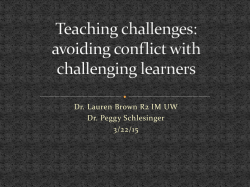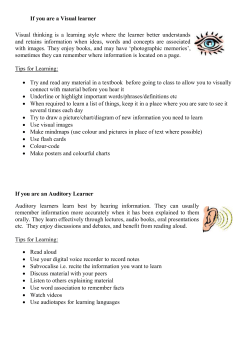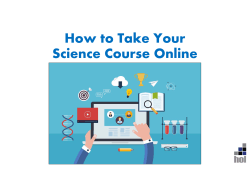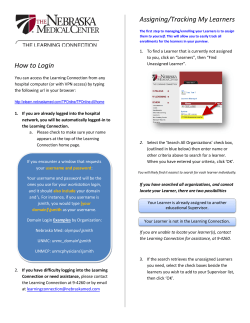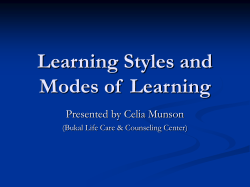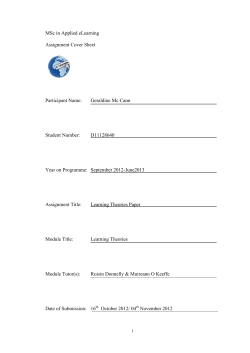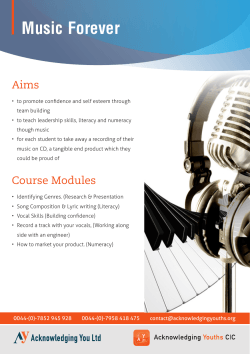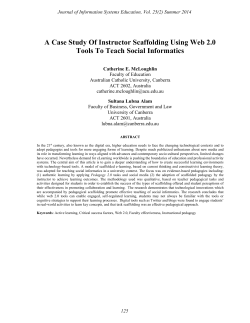
Student Agency Presentation (2015)
ALL (Accelerating Literacy Learning) Developing Student Agency and Self Regulation Nadine Sorrensen University of Auckland What is Student Agency? Why would we want to develop agency in our students? Derek Wenmoth Director of e-Learning at CORE Education “One way of thinking of learner agency is when learners have the ‘power to act’. Agency is when learning involves the activity and the initiative of the learner, more than inputs that are transmitted to the learner from the teacher, from the curriculum, the resources and so forth. When learners move from being passive recipients to being much more active in the learning process, and actively involved in the decisions about the learning, then they have greater agency.” http://www.core.ed.org/thought-leadership/ten-trends ★ Importance of students being active participants in their learning ★ Students knowing: ○ WHAT they need to learn ○ HOW to do the learning ○ WHY they are learning the skill or strategy Remember… ➢ These traits and dispositions need to be taught explicitly ➢ Checking that the student can articulate the learning and the purpose of the learning ➢ Has the student been scaffolded to talk about what they can do and what their goals / next steps for learning are? ➢ You will also need to track and monitor the learning ➢ Can the student transfer the learning to other contexts? ★ Where are your students currently operating, and where they are heading? Expectations, rates of progress and acceleration ★ Literacy Learning Progressions Gap Analysis ★ National Standards Illustrations ★ Students monitor their own progress, talk about where they are and where to next? How do they know? What is the evidence? ★ How will you support your students to set goals? ★ Where will the goals be written / displayed? ★ How will you monitor the progress students are making towards their goals ? ★ How often will the goals be reviewed / new goals set? Key components of Student Agency and Student Self Regulation Academic self-efficacy: ‘I BELIEVE that I can achieve!’ Behavioural self-control Academic self-determination: developing persistence, motivation to learn ….. Teacher-student relationships Developing a ‘culture of learning’ Effective peer relations - ako, supportive ... Effective home-school relationships What is the role of the teacher? What do we need to scaffold, and how do we encourage the students to develop student agency? Where the Student is AT What is the student able to do? (Level of the Literacy Learning Progressions) Where the Student NEEDS TO BE (Level of the Literacy Learning Progressions) Student Shift Actions for Teachers What NEW LEARNING do my students need? What NEW LEARNING do I need? NOTE: Acceleration vs Remediation (Refer to “Learning in the Fast Lane Chapter One) ★ Gradual Release of Responsibility (Optimal Learning Model) ★ Visual Scaffolding Gradual Release of Responsibility Model TEACHER responsibility Focus Lesson / Teacher Modelling ……………………. “ I do it ” “ We do it ” Guided Instruction ……………….. …………………... Collaborative learning …………………. Independent “ You do it together ” Student Responsibility “ You do it alone ” Source: Effective Use of the Gradual Release of Responsibility Model Dr Douglas Fisher, Professor of Language and Literacy Education San Diego State University What is scaffolding? Scaffolding is an instructional technique used to move students progressively toward stronger understanding and greater independence in the learning process. Scaffolding is a temporary support that assists students to reach higher levels of comprehension and skill acquisition that they would not be able to achieve without assistance. What is visual scaffolding? Visual scaffolds are diagrams or images that are used with learners to represent a skill or strategy to prompt or remind them about what to do within their learning Visual scaffolds are particularly useful to support early learners or ESOL learners that may have a limited visual word vocabulary (limited words they can read) 1. Support student learning ★ Visually representing the success criteria for the learning ★ Sentence frames / sentence prompts with images ★ Planning templates with images 2. Develop student agency ★ Having a visual scaffold assists the learner to talk about WHAT they are learning, and HOW to achieve the learning (the actions, skill or strategy) ★ Visual scaffolds assist learners to identify where they have been successful in their learning or to identify areas of their learning that they find challenging or need additional support / assistance Writing: Think about, Record (Encoding), Communicate ideas and Information Reading: Reading (Decoding), Making Meaning, Thinking Critically ★ Articulate their learning ★ Describe the success criteria in their own words ★ Sentence frames ★ Sentence starters ★ Teaching how to ask questions ★ How to answer questions ★ Asking questions of the text ★ Asking questions of others to articulate their thinking / point of view Opportunities to gather student voice: ● At the start of the lesson ○ Tell me what you are learning today and why… ● During the lesson ○ Describe the success criteria and the strategies that they are using to demonstrate their learning ○ Show me in your reading or writing when you are using the skill / you are able to demonstrate your learning ● After the lesson o How did you go with your learning? o How do you know? o What are you able to do? o What did you find tricky / challenging? o What do you need to practice? o What are your next learning steps? ● What is a model text? ● When should I use a model text? ● What are some strategies that I can use to incorporate a model text into my teaching to support the learning of reading and writing (Starting with the Model / Mentor Text) Starting with the Learning Intention and Success Criteria
© Copyright 2025


